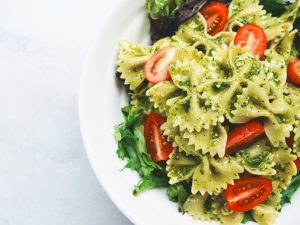
This is Why European Food Tastes Better: A Healthy Comparison
Europe is home to some of the most famous foods in the world: Italian pizza, German currywurst, French crepes, etc. What makes these dishes so mouthwatering?
**Spoiler alert: it might not be the masterful chefs.**
Ever wondered why European food tastes so amazing? A quick overview on how Americans handle food compared to their European counterparts may hold the secret.
Here’s a peek behind the curtain on how the U.S. manages their food production:
Americans focus on portion sizes and longevity.
Most American farmers concern themselves with meeting government regulations rather than producing quality tasting foods packed with nutrients. This means farmers inject chemicals and blast pesticides to create oversized crops and livestock to meet growing consumer demands.
As many farmers straddle federal regulations, they don’t monitor for nutritional value. Consequently, today’s produce contains less nutrition per calorie consumed, meaning Americans need to eat more than their ancestors did to gain the same amount of nutritional value.
When these foods also contain higher amounts of sugars and trans fats, you can see how obesity is an increasing problem in the U.S.
Americans favor convenience over seasonality.
When Americans want a watermelon, they want a watermelon–regardless of seasonality. Americans are bred on convenience. This conditions them to buy what’s available rather than waiting for the optimal harvest season to grow the best produce.
Americans eat processed foods.
Most of the calories Americans consume derive from these ultra-processed foods–and don’t just think McDonald’s and TV dinners. Even everyday foods like breakfast cereals and eggs can be highly processed. Although Americans eat plentifully, they pack on pounds from the excess fats and added sugars.
Studies show that chemically processed foods:
- Include excess sugars
- Comprise artificial flavorings and preservatives
- Maintain less fiber
- Contain high trans fats
- Produce pseudo energy boosts
And Americans wonder why their weight-loss programs don’t seem to work…
Bonus tip: If you see “artificial flavor” listed in a food’s ingredients, this could mean a compilation of 10 or more unknown chemicals.
The American government doesn’t label GMOs.
The U.S. FDA states that foods produced with the use of genetic modification must still meet the same regulatory requirements that apply to all foods.
However, the U.S. government does not mandate labeling for GMO products. This lack of regulation means you could eat something produced with genetic modification and not even know the difference. Though genetic engineering can enhance a part of food, it may also negatively mutate another nutrient. Altering plant and animal genetics is an unpredictable and imprecise science that can result in harmful side effects like:
- Allergies
- New diseases
- Toxins
- Nutritional deficiencies
However, this point may soon become outdated, as the Department of Agriculture has proposed new guidelines for disclosing bioengineered foods in the market.
Americans believe “organic” is healthier.
Slapping “organic” on an American food product means only 70% of the food’s ingredients are truly organic. Foods with the label “USDA Organic” are slightly better, with at least 95% of its ingredients organic.
The U.S. government states if a product qualifies as organic, it must not contain any chemicals, additives, pesticides, synthetics, or genetically engineered substances. This policy keeps away the nasty preservatives, but it doesn’t promise regulated or enhanced nutrients–which the U.S. seems to be lacking.
Now that you better understand how Americans grow and manufacture their food, here’s the clincher that makes European food so much better:
Europeans maintain higher food safety regulations.
This is what the EU says about their food policy:
The EU’s food safety policy covers food from farm to fork. It is designed to guarantee:
1. safe, nutritious food & animal feed
2. high standards of animal health & welfare & plant protection
3. clear information on the origin, content/ labelling & use of food.
Additionally, the University of Michigan states:
“In nearly 50 countries around the world, including Australia, Japan, and all countries in the European Union, there are significant restrictions or outright bans on the production and sale of GM food.”
Combined, these strict food regulations protect against possible, harmful effects that derive from artificial substances Americans routinely inject in their foods–and ingest in their bodies.
Europeans focus on quality.
Europeans won’t tolerate poor, tasteless products. This is evident in where and when they grocery shop:
1. They wait for the proper growing seasons to buy and eat certain produce.
2. Europeans also value farmers markets. These outside markets showcase the best, locally grown specialties. You can find delicious, hand-picked fruits and fresh fish caught that morning within a bustling, gregarious community of buyers and sellers.
This focus on quality extends beyond food; Europe strives for quality living, also. Just think about how much Europeans walk, vacation from work, and approach their days with leisure. This isn’t all coincidence.
Europeans use rapid warning system for outbreaks.
If a contaminated food were to make it to market, the EU has an early warning system to stop the spread. TRACES (Trade Control and Expert System) can trace the entire food chain, from farm to table, to detect the origin of contamination. To remedy the outbreak, these alerts halt production, examine shipments, or recall products–depending on the severity.
European government bans several additives
The EU bans several pesticides, hormones, and GMOs widely used in foods grown or in the U.S. These include:
- Growth hormones in meat animals
- Beef hormones
- rBGH (a hormone in dairy cattle)
- Atrazine (weed killer)
These chemicals have caused heart and liver problems, among others, in animals. Studies of the effects these additives have on humans are inconclusive to date.
How Can Americans Eat Healthier?
It all boils down to this question. After learning about the poor American diet, you may wonder how you can change your eating habits to reflect a healthier lifestyle. Check out these tips:
1. Cook veggies with herbs.
If you think veggies are tasteless and limp, trying steaming them with herbs and spices to add back some nutrition.
2. Buy organic to reduce pesticide exposure.
Eating organic foods won’t solve all your nutrition problems, but it will at least reduce your exposure to harmful pesticides. Shop for products with the “Non-GMO Project Verified” stamp of approval. This will assure you the product is safely organic.
3. Avoid eating genetically modified foods.
Before you buy anything at the grocery store, check the ingredients label. If it says anything about genetic modification or chemical engineering, put it back. You don’t need to expose your body to those harmful chemicals any longer, especially now that you know about healthier substitutions.
From personal preference and culture to federal regulations, it’s clear European food is healthier and more nutritious, which results in better taste. If Americans want to reflect this healthier diet, they need to exercise savvy shopping and clever cooking. It takes time and planning, but it’s possible and valuable to make the changes.










